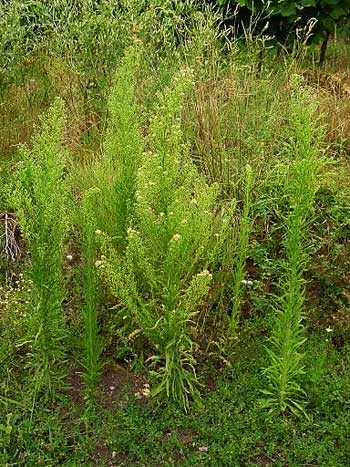Contents:
Common Names | Parts Usually Used | Plant(s) & Culture | Where Found | Medicinal Properties
Uses | Formulas or Dosages | Warning | Bibliography
Scientific Names

- Conyza canadensis L.
- Erigeron candensis L.
- Composite family
Common Names
- Bitterweed
- Blood staunch
- Butterweed
- Canada fleabane
- Colt’s tail
- Cow’s tail
- Fleabane
- Mare’s tail
- Pride weed
- Scabious
Parts Usually Used
Leaves or plant
Back to Top
Description of Plant(s) and Culture
Horseweed is a native North American annual plant with stiff, erect, branched and leafy stems, 1-7 feet tall. The grooved, bristly, and hairy stem bears alternate, entire or serrate leaves that are oblanceo-late and petioled near the bottom of the plant, narrow and sessile near the top. Numerous tiny (to 1/4 inch), green and white flower heads appear in panicled terminal clusters from June to November. Each flower head has many greenish white ray florets which do not spread and many yellow disk florets.
Back to Top
Where Found
Found in North and South America and Europe. Generally inhabits waste places, roadsides, fields, and meadows all over North America except the extreme northern parts.
Back to Top
Medicinal Properties
Astringent, diuretic, styptic, tonic
Back to Top
Uses
Horseweed is particularly suitable for treatment of diarrhea, dysentery, internal hemorrhage, and hemorrhoids. Native Americans boiled the root to make a tea for menstrual irregularities. It has also been recommended for bladder problems and rheumatism. Excellent for cholera, colon trouble, and summer complaint. Good for tuberculosis, kidney gravel, diabetes, hemorrhages of the stomach, nosebleeds, fevers, bronchitis, coughs, cystitis, and dropsy.
Africans used it for eczema and ringworm.
Back to Top
Formulas or Dosages
The whole plant in flower, dried in bunches.
Infusion: steep 1 level tsp. leaves or plant in 1 cup water for 30 minutes. Take 1-2 cups a day.
Enema: steep 1 tsp. leaves or plant in 1 qt. boiling water for 20 minutes. Use hot (110-112 degrees F.).
Back to Top
Warning
May cause contact dermatitis.
Back to Top
Bibliography
![]() Back to Eden
Back to Eden, by Jethro Kloss; Back to Eden Publishing Co., Loma Linda, CA 92354, Original copyright 1939, revised edition 1994
![]() The Herb Book
The Herb Book, by John Lust, Bantam Books, 666 Fifth Avenue, New York, NY. copyright 1974.
![]() Eastern/Central Medicinal Plants
Eastern/Central Medicinal Plants, by Steven Foster and James A. Duke., Houghton Mifflin Company, 215 Park Avenue South, New York, NY 10000
![]() Webster’s New World Dictionary
Webster’s New World Dictionary, Third College Edition, Victoria Neufeldt, Editor in Chief, New World Dictionaries: A Division of Simon & Schuster, Inc., 15 Columbus Circle, New York, NY 10023
![]() Indian Herbalogy of North America
Indian Herbalogy of North America, by Alma R. Hutchens, Shambala Publications, Inc., Horticultural Hall, 300 Massachusetts Avenue, Boston, Massachusetts 02115, 1973
 How Indians Use Wild Plants for Food, Medicine & Crafts
How Indians Use Wild Plants for Food, Medicine & Crafts, by Frances Densmore, Dover Publications, Inc., 180 Varick Street, New York, NY 10014, first printed by the United States Government Printing Office, Washington, in 1928, this Dover edition 1974
 An Instant Guide to Medicinal Plants
An Instant Guide to Medicinal Plants, by Pamela Forey and Ruth Lindsay, Crescent Books (January 27, 1992).
